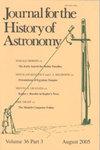Annibale Riccò and the catoptric proof of the Earth’s curvature
IF 0.3
3区 哲学
Q3 HISTORY & PHILOSOPHY OF SCIENCE
引用次数: 0
Abstract
Phenomena as common as the daily rising or setting of the Sun can reveal, upon careful examination, something surprising and unexpected, which has been attracting scientific attention belatedly and had to wait long before being explained. From systematic observation of sunrises over the marine horizon, the Italian astronomer Annibale Riccò (1844–1919) unexpectedly claimed to have recognized a new and novel evidence of the Earth’s roundness, scrutinizing distorted images of the Sun reflected off waters. Others had previously come to a similar conclusion, but it was Riccò’s pioneering work that brought this “catoptric” proof of the Earth’s curvature to the scientific limelight of his time. The interesting debate ensued gave rise to more articulated interpretations of Riccò’s observations, including recovery of olden “dioptric” explanations. The catoptric model was eventually abandoned, as it does not adequately take into account the effects of atmospheric refraction and above all the observed phenomenon is not genuinely “reflective.” The argument is nevertheless correct in principle and retains historical and pedagogical interest.Annibale Riccó与地球曲率的光学证明
像太阳每天升起或落下这样常见的现象,经过仔细研究,可以揭示出一些令人惊讶和意想不到的事情,这些事情引起了科学界的关注,但为时已晚,必须等待很长时间才能得到解释。意大利天文学家Annibale Riccå(1844-1919)通过对海洋地平线上日出的系统观测,出人意料地声称自己发现了地球圆度的一个新的新颖证据,仔细观察了海水反射的太阳扭曲图像。其他人此前也得出了类似的结论,但正是Riccå的开创性工作,将这一地球曲率的“猫眼”证明带到了他那个时代的科学聚光灯下。随后发生的有趣的辩论引发了对Riccå的观察结果的更清晰的解释,包括恢复旧的“屈光”解释。Catoptic模型最终被放弃,因为它没有充分考虑到大气折射的影响,而且最重要的是,观察到的现象并不是真正的“反射性的”。然而,这一论点在原则上是正确的,并保留了历史和教学的兴趣。
本文章由计算机程序翻译,如有差异,请以英文原文为准。
求助全文
约1分钟内获得全文
求助全文
来源期刊

Journal for the History of Astronomy
地学天文-科学史与科学哲学
CiteScore
0.50
自引率
25.00%
发文量
44
审稿时长
>12 weeks
期刊介绍:
Science History Publications Ltd is an academic publishing company established in 1971 and based in Cambridge, England. We specialize in journals in history of science and in particular history of astronomy.
 求助内容:
求助内容: 应助结果提醒方式:
应助结果提醒方式:


